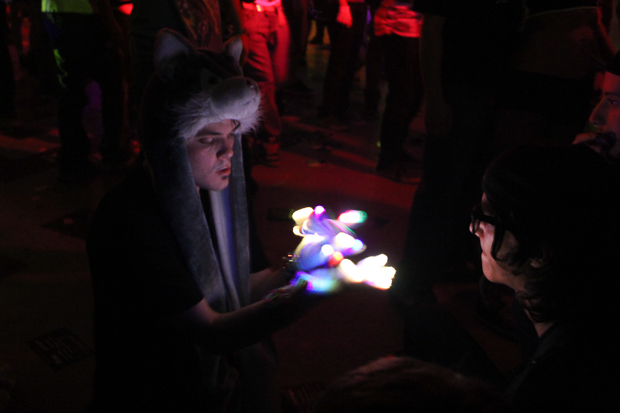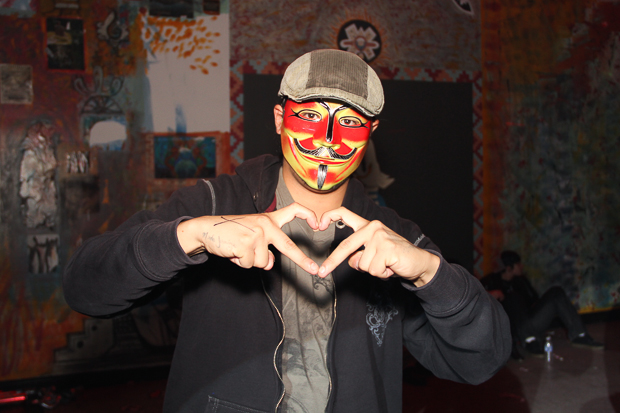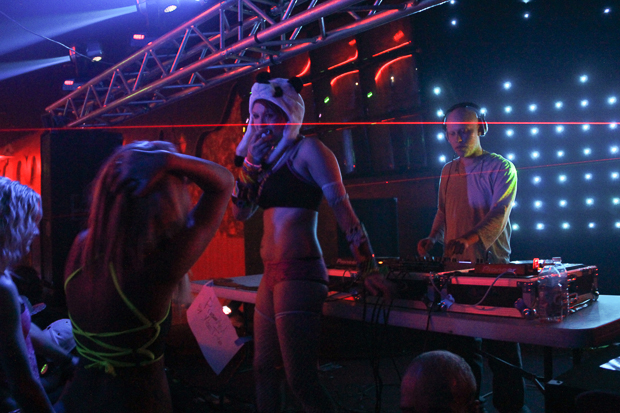EDM has grown so popular, the dance music is hitting the campaign trail
By Althea Legaspi

EDM has grown so popular, the dance music is hitting the campaign trail
By Althea Legaspi
First came disco, then house music and then raves. Now there’s a new generation dancing to the latest incarnation of EDM. The acronym may sound more like a disease to puzzled parents. But EDM, or electronic dance music, has grown so popular, some political campaigns are using it to woo young voters. And Chicago’s playing a major role in that scene.
Over on the Southwest Side, scores of teens are dancing wildly into the wee hours. They’re scantily clad, wearing knee-high fake-fur boots in all colors of the rainbow, and some are draped in neon shorts, bracelets and bikini tops. Others wield glow sticks.
They’re dancing in a bare-bones vacant space with a DJ booth and pulsating lights. The beat is unrelenting and throbbing.
“Right now we’re throwing it in a burned out arcade,” says the 20-year-old underground promoter throwing this illicit rave, who goes by the name of Sub Vice. “There’s only four decent venues in Chicago, and the cops know about all of them. So it’s either a crackhouse or some large box that the cops know about before you’ve put it up on your infoline.”
“What people don’t realize is like this is their Nirvana,” says Zach Partin, publicist for the well-known EDM promoter React Presents. “This is their ‘90s, you know, that was going on at the time. This is their alternative culture.”

Massive festivals such as Chicago’s North Coast and Spring Awakening and the Ultra in Miami attract hundreds of thousands each year. Established venues like the Congress, Metro and The Mid sell out DJ-oriented shows in Chicago. EDM artists are even tapped to do commercials for companies like HP and Kmart.
A friend, DJ Greg Corner, says the craze started taking hold a few years ago. Corner helped launch Dark Wave Disco, one of the first indie-electro parties held at venues.
“It probably started in 2008,” Corner says. “I would say the next wave started kinda taking over, and it’s the biggest it’s ever been, hands down. It’s never been this big.”
Back in the day, in the ‘80s, if you wanted to hear house music you had to venture underground to warehouses and private homes. Very few venues booked DJ acts as headliners outside of some exceptions like Smart Bar.
“Back then, it was very renegade,” he says. As a teen, to avoid age limits at those clubs, Corner started DJ’ing parties in his home. Some locations at the time were even deeper underground, as he learned from a promoter:
“I go to South Michigan Avenue, and I’m like ‘Where’s the party?’ He’s like, ‘I don’t know yet.’ I’m like ‘What do you mean?’ … So we went into this office complex. Took an elevator up and they’re going, using a screwdriver, opening doors to like these office rooms, and they found one with electricity and it’s like, ‘This is where the party is’.”

Some political campaigns are even turning to EDM to attract younger voters. Along with videos by actors, musicians and politicians, the Obama campaign’s YouTube site features a PSA by DJs. The group in the video, DJs for Obama, includes noted artists like Steve Aoki, and they’re holding events and Tweeting, too.
DJ Mikul Wing of Midnight Conspiracy thinks the music’s popularity is a reaction to the current economic and political climate.
“It’s just a good, fun thing,” he says. “It’s like an escape from the realities of the world that’s out there … and that’s what’s driven the direction it’s really gone.”
What’s also helped the music go viral is the internet.
Rick Carrico of the Chicago DJ/Producer duo Team Bayside High says artist often give their tracks away for free on the web, where they’re easily discovered and shared. The duo posted their remix of Matt and Kim’s “Let’s Go” and got 15,000 plays within a week.

“Everybody can throw an event now, via the internet, promote it, and anybody can create a track. So you’ll have people everyday figuring this out and starting to do it. You’re going to have tons of people … It allowed the masses to do what at a certain point only a few were able do.”
The promoter Sub Vice is a good example. He started going to parties at 13 and then threw his own events, like this Southwest Side rave. He says the music and party vibe are what make this so important.
“It’s just sounds terrible to old people and that’s always a plus,” he adds.
One of the people here dancing is a 19-year-old woman who goes by the name of Gizmo. She says she hits EDM parties like this weekly.
“You get to come a big group of people that you know, and they’re your friends. I mean, friends isn’t even the right word for it – it’s family.”
She takes one quick breath before she jumps back on the dance floor.
NOTE: Music in this story included “Steve Jobs,” featuring Angger Dimas, by Steve Aoki (from Wonderland album); “Circus Bells,” by Robert Armani; “Earthquakey People,” featuring Rivers Cuomo, by Steve Aoki; “Sentinel (Original Mix),” by Midnight Conspiracy; and Matt and Kim - “Let’s Go (Team Bayside High Remix)”, by Team Bayside High.


